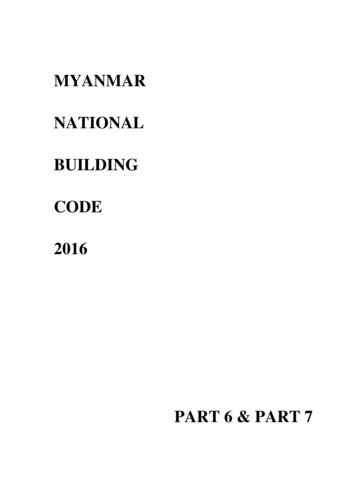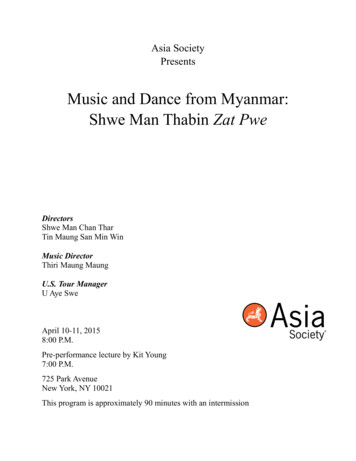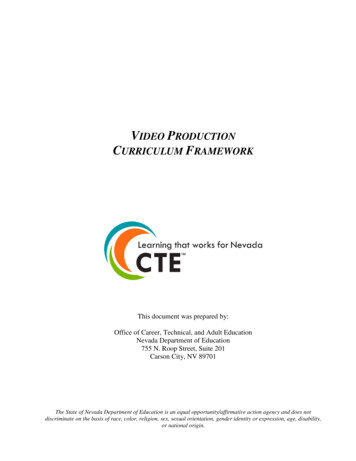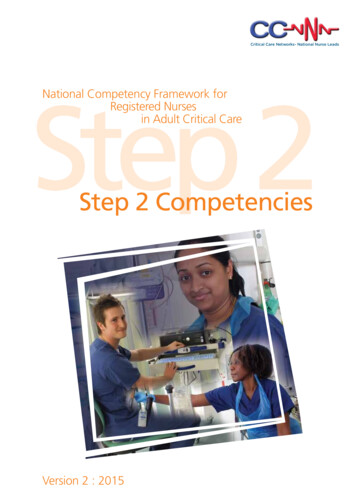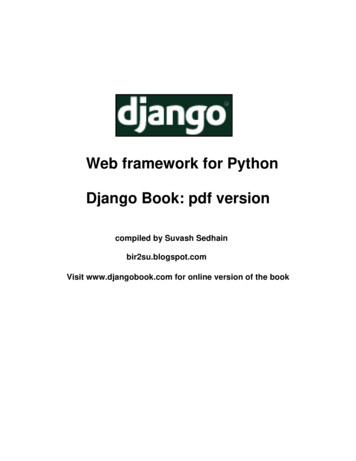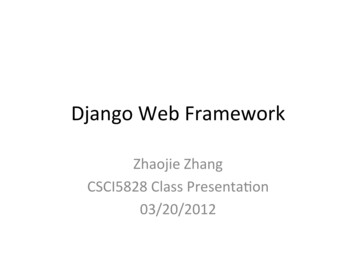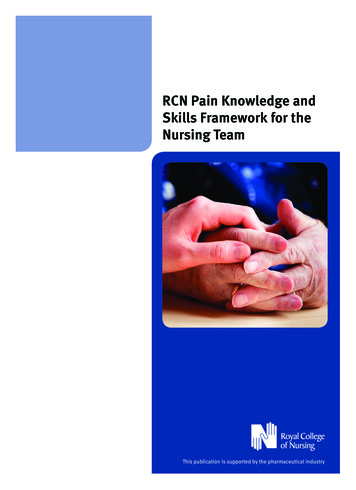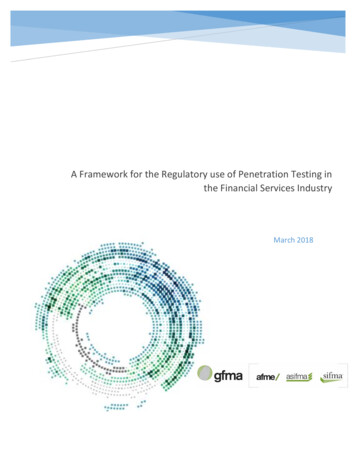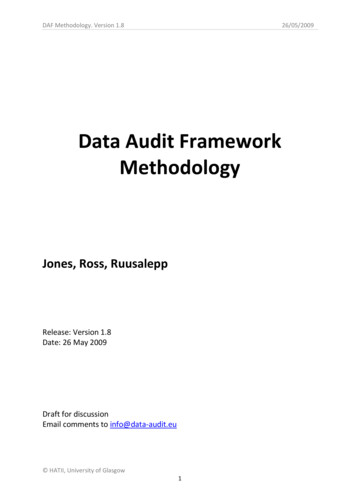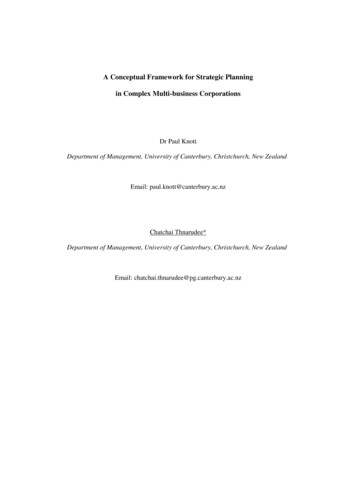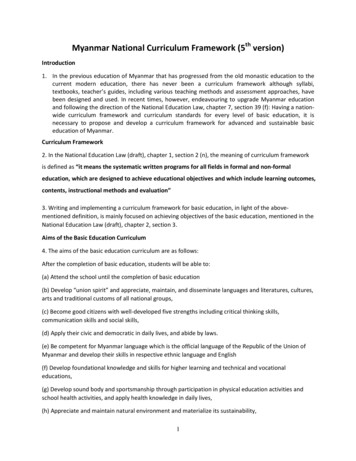
Transcription
Myanmar National Curriculum Framework (5th version)Introduction1. In the previous education of Myanmar that has progressed from the old monastic education to thecurrent modern education, there has never been a curriculum framework although syllabi,textbooks, teacher’s guides, including various teaching methods and assessment approaches, havebeen designed and used. In recent times, however, endeavouring to upgrade Myanmar educationand following the direction of the National Education Law, chapter 7, section 39 (f): Having a nationwide curriculum framework and curriculum standards for every level of basic education, it isnecessary to propose and develop a curriculum framework for advanced and sustainable basiceducation of Myanmar.Curriculum Framework2. In the National Education Law (draft), chapter 1, section 2 (n), the meaning of curriculum frameworkis defined as “it means the systematic written programs for all fields in formal and non-formaleducation, which are designed to achieve educational objectives and which include learning outcomes,contents, instructional methods and evaluation”3. Writing and implementing a curriculum framework for basic education, in light of the abovementioned definition, is mainly focused on achieving objectives of the basic education, mentioned in theNational Education Law (draft), chapter 2, section 3.Aims of the Basic Education Curriculum4. The aims of the basic education curriculum are as follows:After the completion of basic education, students will be able to:(a) Attend the school until the completion of basic education(b) Develop “union spirit” and appreciate, maintain, and disseminate languages and literatures, cultures,arts and traditional customs of all national groups,(c) Become good citizens with well-developed five strengths including critical thinking skills,communication skills and social skills,(d) Apply their civic and democratic in daily lives, and abide by laws.(e) Be competent for Myanmar language which is the official language of the Republic of the Union ofMyanmar and develop their skills in respective ethnic language and English(f) Develop foundational knowledge and skills for higher learning and technical and vocationaleducations,(g) Develop sound body and sportsmanship through participation in physical education activities andschool health activities, and apply health knowledge in daily lives,(h) Appreciate and maintain natural environment and materialize its sustainability,1
(i) Become global citizens with awareness and appreciation of human diversity and abilities to practicebasic knowledge of peace in their daily lives,(j) Take pride in being a citizen of the Union of Myanmar,5. In order to realize the above-mentioned aims, thirteen guiding principles as mentioned in thefollowing need to be employed in the design and development of Basic Education Curriculum inMyanmar.Guiding Principles for Basic Education Curriculum in MyanmarThirteen guiding principles to be employed in the design and development of Basic EducationCurriculum in Myanmar are as follows:(a) All-round, Balanced DevelopmentStudents must be nurtured with focus on all-round, balanced development especially in terms ofintellectual, physical, social, moral, emotional and aesthetic dimensions.(b) Good CitizenshipStudents must be nurtured to become good citizens both at the national level and at the globallevel.(c) 21st Century Skills21st century skills must be developed in order to pave the way for the development of Myanmarsociety both at the national level and at the global level. Thus, these skills and themes become anintegral part of the school curriculum and are to be designed for learning (i) through integratedstudy in all related areas and (ii) through specialized study as a separate area of learning.(d) Notion of Completion in ItselfStudents must be well developed in terms of necessary knowledge, skills and attitudes as anevidence of completion in itself at the end of each level of the three levels of Basic Education, i.e.,Primary, Middle and High School levels(e) Preparation for Higher LearningStudents must have necessary foundational knowledge, skills and attitudes for higher learningthat can be pursued either in the form of academic learning or vocational learning.(f) Preparation for One’s life in Myanmar Society and Modern EconomyStudents must have necessary learning experiences as a preparation for their lives in MyanmarSociety and getting on well with the modern economy.(g) Balance in Academic LiteracyA balance in academic literacy is to be achieved through promotion of academic development inboth science and arts areas of learning.2
(h) Appreciation of All Cultures, Customs and TraditionsStudents must be nurtured to develop an appreciation of all cultures, customs and traditions ofall national groups at the national level and all other nations at the global level.(i) Medium of InstructionEither of Myanmar and English languages or both can be used as the medium of instruction. Ifnecessary in the basic education level, an ethnic language can be used as the medium ofinstruction together with Myanmar language. (National Education Law section 43)(j) Languages of National GroupsAccording to the National Education Law, chapter 8, section 44 (In Regions or States, the teachingof ethnic languages and literature can be implemented by the Regional or State governments,starting from the primary level and step by step extending it to higher grades), textbooks forteaching ethnic language must be prepared by responsible personnel in respectiveStates/Regions. These national language textbooks need to be approved by the Basic EducationCurriculum Committee. Decisions regarding how to and when to use these national languagetextbooks are to be made by the respective States/Regions.(k) Service to Family, School, Community and SocietyStudents must have necessary opportunities to develop the notion of service to family, school,community and society.(l) Peaceful Coexistence and Living in HarmonyThe notion of Peaceful Coexistence and Living in Harmony and Conflict Resolution Skills must bedeveloped in students at all levels of society - community, national and global.(m) Promoting EqualityThe curriculum, textbooks and other teaching learning materials must be one that promotesstudents’ learning equally. Despite there are any differences in gender, race, language, andeconomic status, equal learning environment should be provided.The levels and grades of the Basic Education7. In the National Education Law, chapter 5, section 16, 18 and 19, the level of basic education will bedesignated as follows:Section 16 (a) Basic education is divided into the following three levels having led to 12 year of totallyeducational terms after the completion of kindergarten,i. Primary education,ii. Middle school education,iii. High school education,3
a. Kindergarten shall be regarded as the basic level of primary education,b. In order to complete one of the levels of education listed in sub-section (a), the competency ofeducational level shall be assessed.18.a. Children who have attained the age of five years shall enter kindergarten.b. Children who have attained the age of six years shall enter the first grade of primary school.19. English shall be taught starting from the primary level.The Curriculum structures of Basic Education8. The Curriculum Structures of Basic Education will be formed as follows:(a) Kindergarten Education Curriculum Framework(b) Primary Education Curriculum Framework(c) Middle School Education Curriculum Framework(d) High School Education Curriculum FrameworkKindergarten Education Curriculum Structure9. Aims of kindergarten education are as follows:(a) To be self-directed, independent, have a strong sense of being,(b) To be happy, healthy, and well-nourished,(c) To be wishing to explore further reading, writing, mathematical and knowledge activities, and(d) To be contributing to the well-being of the group10. Curriculum Structure:In order to implement kindergarten education, the curriculum structureis formed with the following six learning areas according to the students’ age and developmental stage.(a) Wellbeing(b) Moral, Social and Emotional Development(c) Communication(d) Appreciation of the Arts and Creativity(e) Exploring Mathematics(f) Knowledge and Understanding of the World4
11. Detailed learning outcomes for each learning area will be designated and a plan is made in the formof a written activity guide which helps students achieve those outcomes. There are four instructionalhours per day, 20 hours per week and 32 weeks per year in kindergarten school year, and the total ofinstructional hours per year is 640.12. Teaching Learning ApproachesDepending on the different levels of intelligence, various ways of learning, integrated methods andapproaches that can enable children to participate actively should be used. Learning activities should beprepared in consideration of learning contents and children’s needs and interests, which can promoteto create better environment for learning, which is known as Child Centered Approach (CCA).13. AssessmentThere are no traditional formal written tests or examinations. Assessment is a continuous plannedprocess of identifying, gathering and interpreting information about the development and learning ofyoung children. Teachers must keep the records for that and use the information to enhance theirdevelopment and learning through planned activities.Primary Education Curriculum Framework14. Aims of primary education are as follows:(a) To demonstrate achievement of age-appropriate, balanced, all-round development, i.e.,intellectually, physically, socially, morally, socially and economically,(b) To demonstrate basic mastery of four skills of Myanmar language (listening, speaking, reading andwriting skills) and to apply them in daily life according to the age-level,(c) To demonstrate basic mastery of four skills (listening, speaking, reading and writing skills) of anethnic language designated in each State and Region and to apply them in their daily life,(d) To develop the foundation of four skills of English language (listening, speaking, reading and writingskills) according to the age level,(e) To skillfully perform basic mathematical calculations in daily life application,(f) To make scientific exploration about natural phenomena in one’s environment and apply theacquired basic science knowledge and skills in daily-life,(g) To understand geographical facts, situation and historical events of Myanmar and develop desirabledispositions such as love of, and loyalty to the Republic of the Union of Myanmar,(h) To develop basic knowledge, skills, attitudes, aesthetic appreciation, and behavior which areassumed to be the basic characteristics of a good citizen, and(i) To develop a sound mind and in a sound body as a result of participation in physical activities andapplication of health-related knowledge and attitude in daily life situations5
15. Curriculum StructureThe primary curriculum consists of 10 learning areas. They are Myanmar, English, Mathematics, Science,Social Studies, Physical Education, Life Skills, Aesthetics, Moral and Civics and Local Curriculum.16. Primary school year consists of 36 weeks and the total of teaching hours per year is between 840and 960. As for the lower primary level that is from grade 1 to grade 3, one period is 40 minutes, and 7periods per day which is 4 hours 40 minutes. The total of teaching hours per year is 840 hours. As for theupper primary level that is grade 4 and grade 5, one period is 40 minutes, and 8 periods per day which is5 hours 20 minutes. The total number of teaching hours per year is 960 hrs. The learning area andallocation of periods are shown in table 16
Learning areaGrade 1Periods perweekTotal hoursper weekGrade 2Totalhoursper yearPeriods perweekTotal hoursper weekGrade 3Total hoursper yearPeriods perweekTotal hoursper weekGrade 4Grade 5Total hoursper yearPeriods perweekTotal hoursper weekTotal hoursper yearPeriods perweekTotal hoursper weekTotal hoursper yearMyanmar85 hrs 20mins19285 hrs 20mins19285 hrs 20mins19274 hrs 40mins16874 hrs 40mins168English32 hrs7232 hrs7232 hrs7253 hrs 2012053 hrs 20120Maths74 hrs 40mins16874 hrs 40mins16874 hrs 40mins16864 hrs14464 hrs144Science21 hr 20 mins4821 hr 20 mins4821 hr 20 mins4832 hrs7232 hrs72Social Studies21 hr 20 mins4821 hr 20 mins4821 hr 20 mins4832 hrs7232 hrs72Physical Education21 hr 20 mins4821 hr 20 mins4821 hr 20 mins4832 hrs7232 hrs72Life Skills21 hr 20 mins4821 hr 20 mins4821 hr 20 mins4832 hrs7232 hrs72Aesthetic21 hr 20 mins4821 hr 20 mins4821 hr 20 mins4821 hr 20 mins4821 hr 20 mins48Moral and Civics21 hr 20 mins4821 hr 20 mins4821 hr 20 mins4832 hrs7232 hrs72Total3020 hrs7203020 hrs7203020 hrs7203523 hrs 20mins8403523 hrs 20mins840There must not be more than 5 periods per week, 120 hrs per year. Total teaching hours for lower primary level (840)Total teaching hours for upper primary level (960)Local curriculumEthnic languagesTheir histories, traditions and culturesLocal business situationAgricultural businessesBasic computerAbove-mentioned subjects are planned to be taught in accordance with the local needs.Total There must not be more than 60 hours per year for ‘School Council activities’ performed outside school hours and ‘Interest Group activities’.There must not be more than 900 hours per year for lower primary level and 1020 hours per year for upper primary level.Table (1) learning area and period allocation at the primary level of Basic Education7
17. Local CurriculumLocal Curriculum is a period that individual states/regions, townships or schools can decide inconsideration of their local educational needs. Arrangements are made to teach the local curriculumeither across the subjects or within individual subjects. The main contents dealt in as local curriculumare learning ethnic languages,
Myanmar National Curriculum Framework (5th version) Introduction 1. In the previous education of Myanmar that has progressed from the old monastic education to the current modern education, there has never been a curriculum framework although syllabi, textbooks, teacher’s guides, including various teaching methods and assessment approaches, have been designed and used. In recent times .
